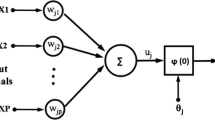Abstract
An attempt is made to derive wind speed from wave measurements by carrying out an inverse modeling. This requirement arises out of difficulties occasionally encountered in collecting wave and wind data simultaneously. The wind speed at every 3-h interval is worked out from corresponding simultaneous measurements of significant wave height and average wave periods with the help of alternative data-driven methods such as program-based genetic programming, model trees, and locally weighted projection regression. Five different wave buoy locations in Arabian Sea, representing nearshore and offshore as well as shallow and deep water conditions, are considered. The duration of observations ranged from 15 months to 29 months for different sites. The testing performance of calibrated models has been evaluated with the help of eight alternative error statistics, and the best model for all locations is determined by averaging out the error measures into a single evaluation index. All the three methods satisfactorily estimated the wind speed from known wave parameters through inverse modeling. The genetic programming is found to be the most suitable tool in majority of the cases.








Similar content being viewed by others
References
Arena G, Briganti R, Corsini S, Franco L (2001) The Italian wave measurement buoy network: 12 years of management experience. In: Edge BL, Hemsley M (eds) Proceedings of the waves 2001 conference, San Francisco, Sept 2–6, 2001, pp 86–95
Atkeson C, Moore A, Schaal S (1997) Locally weighted learning. Artif Intell Rev 11(4):76–113
Charhate SB, Deo MC, Londhe SN (2008) Inverse modeling to derive wind parameters from wave measurements. Appl Ocean Res (under review)
Francone FD (1998) Discipulus owner’s manual. Machine Learning Technologies, Inc., Littleton, Colorado.
Koza KJ (1992) Genetic programming—on the programming of computers by means of natural selection. MIT Press, Cambridge
Quinlan JR (1992) C4.5: programs for machine learning. Morgan Kaufmann, San Francisco
Schaal S, Atkeson C (1998) Constructive incremental learning from only local information. Neural Comput 10(8):2047–2084
Solomatine DP, Xue Y (2004) M5 model trees compared to neural networks: application to flood forecasting in the upper reach of the Huai River in China. ASCE J Hydrol Eng 9(4):491–501
Toussaint M (2006) Locally weighted projection regression software. http://www.marc-toussaint.net/source-code/index.html
Tseng CM, Jan CD, Wang JS, Wang CM (2007) Application of artificial neural networks in typhoon surge forecasting. Ocean Eng 34:1757–1768
Vijayakumar S, Schaal S (2000) Locally weighted projection regression: an O (n) algorithm for incremental real time learning in high dimensional space. In: Proceedings of the international conference on machine learning ICM, pp 1079–1086
Witten IH, Frank E (2000) Data mining: practical machine learning tools and techniques. Morgan Kaufmann, San Francisco.
Author information
Authors and Affiliations
Corresponding author
Appendices
Appendices
1.1 Appendix 1: Linear model in LWPR
The four-step algorithm to fit a linear model locally is as below:
Let x q be query point and p be the training points {x i , y i } in memory. Then the prediction is made as follows:
-
1.
Compute diagonal weight matrix W with elements as per Eq. 2
-
2.
Construct matrix X and vector y such that
where,
-
3.
Compute regression parameter for locally linear model
-
4.
The prediction for given x q is thus
where β n+1 denotes the (n + 1)th element of the regression vector β.
1.2 Appendix 2: The error measures
1.2.1 Correlation coefficient
It measures the linear association of two variables. The measure, however, is very sensitive to deviations at larger observations and does not reflect nonlinear associations.
where, \( x = X_{i} - \bar{X} \), and \( y = Y_{i} - \bar{Y} \); X i = Observed values at time i, \( \bar{X} = {\text{Mean of}}\; X \), Y i = Modeled value at time i, \( \bar{Y} = {\text{Mean of}}\;Y \), n = number of input–output pairs.
1.2.2 Root mean square error
This measure indicates an overall agreement (without any upper bound) between the observed and modeled datasets. This measure is good for predictions arrived at iteratively but gives only an overall picture of errors.
1.2.3 Mean absolute error
This statistic also gives an overall agreement between the observed and modeled datasets and is useful for practical interpretations. It is non-negative and has no upper bound but provides no information about underestimation or overestimation. It is not weighted towards high or low magnitude events, but instead evaluates all deviations from the observed values, in an equal manner and regardless of sign. MAE is comparable to the total sum of absolute residuals.
1.2.4 Relative absolute error
This measure comprises the total absolute error made relative to what the total absolute error would have been if the forecast had simply been the mean of the observed values. It is a non-negative metric that has no upper bound. It is dimensionless.
1.2.5 Mean absolute relative error
This metric comprises the mean of the absolute error made relative to the observed record and unlike MAE it is dimensionless and hence suitable to compare across many parameters. It is a non-negative metric that has no upper bound.
1.2.6 Mean square logarithmic error
This is similar to RMSE but compares the logged values of observed and modeled data. It is more suitable than RMSE for low values as it is based on logarithmic transformations.
1.2.7 Inertial root mean square error
This is obtained by dividing the RMSE by the standard deviation of the differential series. The use of differential series enables understanding of the model to predict changes in observation.
where,
1.2.8 Error ratio of forecasted peak
This metric comprises the difference between the highest value in the modeled dataset and the highest value in the observed dataset, made relative to the magnitude of the highest value in the observed dataset. It can be either positive or negative. It is unbounded.
Rights and permissions
About this article
Cite this article
Daga, M., Deo, M.C. Alternative data-driven methods to estimate wind from waves by inverse modeling. Nat Hazards 49, 293–310 (2009). https://doi.org/10.1007/s11069-008-9299-2
Received:
Accepted:
Published:
Issue Date:
DOI: https://doi.org/10.1007/s11069-008-9299-2




